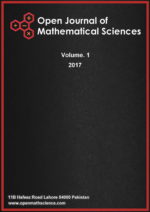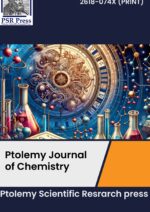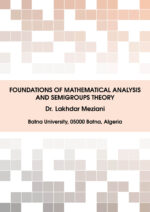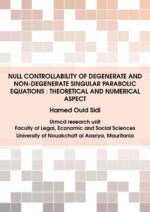Ptolemy Scientific Research Press (PSR Press)is a highly regarded publisher of scientific literature dedicated to bringing the latest research and findings to a broader audience. With a focus on cutting-edge research and technology, Ptolemy Scientific Research Press offers a range of publications catering to professionals, researchers, and student’s needs. Whether looking for information on the latest breakthroughs in physics, biology, engineering, or computer science, you can trust Ptolemy Scientific Research Press to deliver insightful, accurate, and engaging content. With its commitment to quality, accessibility, and innovation, Ptolemy Scientific Research Press is an essential resource for anyone interested in science and technology.

Latest Published Articles
OMS-Vol. 3 (2019), Issue 1, pp. 07–10 Open Access Full-Text PDF
Alagarsamy Nandhini, Devaraj Vivek, Elsayed M. Elsayed
Abstract:In this paper, we study Katugampola fractional differential equations (FDEs) with nonlocal conditions on time scales. By means of standard fixed point theorems, some new sufficient conditions for the existence of solutions are established.
Weaker form of totally continuous functions
OMS-Vol. 3 (2019), Issue 1, pp. 01–06 Open Access Full-Text PDF
Md. Hanif Page and Lakshmi Narayan Mishra
Abstract:The objective of this paper is to study new type of continuous functions called totally \(\alpha\)gs-continuous functions using $\alpha$gs-open sets. Furthermore we discuss covering properties and obtain their characterizations by including counter examples.
Higher order nonlinear equation solvers and their dynamical behavior
OMA-Vol. 2 (2018), Issue 2, pp. 172–193 | Open Access Full-Text PDF
Sabir Yasin, Amir Naseem
Abstract:In this report we present new sixth order iterative methods for solving non-linear equations. The derivation of these methods is purely based on variational iteration technique. To check the validity and efficiency we compare of methods with Newton’s method, Ostrowski’s method, Traub’s method and modified Halleys’s method by solving some test examples. Numerical results shows that our developed methods are more effective. Finally, we compare polynomigraphs of our developed methods with Newton’s method, Ostrowski’s method, Traub’s method and modified Halleys’s method.
Reverse Zagreb and Reverse Hyper-Zagreb Indices for Silicon Carbide \(Si_{2}C_{3}I[r,s]\) and \(Si_{2}C_{3}II[r,s]\)
EASL-Vol. 1 (2018), Issue 2, pp. 37–50 | Open Access Full-Text PDF
Abaid ur Rehman Virk, Mirza Naveed Jhangeer, M. A. Rehman
Abstract:Topological indices collect information from the graph of molecule and help to predict properties of underlined molecule. Zagreb indices are among the most studied topological indices due to its applications in chemistry. In this report we compute first and second reversed Zagreb indices and first and second reversed Hyper Zagreb indices for \(Si_{2}C_{3}I[r,s]\) and \(Si_{2}C_{3}II[r,s]\). Moreover we also compute first and second reversed Zagreb polynomials and first and second reversed Hyper Zagreb polynomials for \(Si_{2}C_{3}I[r,s]\) and (Si_{2}C_{3}II[r,s]\).
Isolation, Purification and Complex Formation of Nicotine Alkaloid
EASL-Vol. 1 (2018), Issue 2, pp. 30–36 | Open Access Full-Text PDF
Sajid Mahmood, Saiqa Jameel, Zaheer Ahmad
Abstract:Nicotiana tabacum is rich with medicinal importance. The aim of the study is to isolate, purify and compare nicotine (3-[1-Methylpyrolidine-2 yl] pyridine) from different brands of cigarettes. Isolation is carried out by liquid-liquid extraction using ether as solvent. Crude nicotine samples are further purified with SPE (solid phase extraction) method. Nicotine crystals are complexed with zinc chloride (\(ZnCl_{2}\)). Fine and pure crystals of metal complexes are obtained with Nic-C and Nic-D. However, no complex formation is synthesized with Nic A and Nic-B due to impurities in the sample which is confirmed by thin layer chromatography. Antibacterial activity of the samples is carried out against different strains of bacteria which showed positive results for Nic-C and Nic-D. The outcomes of the study reveal that Zinc-Nicotine complexes can be used as therapeutic agents and anti-sickness agents in sickle cell disease.
Biological Synthesis and Characterization of Chromium (iii) Oxide Nanoparticles
EASL-Vol. 1 (2018), Issue 2, pp. 23–29 | Open Access Full-Text PDF
Zaheer Ahmad, Aisha Shamim, Sajid Mahmood, Tariq Mahmood, Farman Ullah Khan
Abstract:Nanoparticles are nanosized clusters with dimensions less than 100nm. Nanoparticles are fabricated by physical, chemical, and biological methods. Physical and chemical methods are energy intensive and involve hazards of contaminations. Biological synthesis of nanoparticles is environment friendly, less toxic and cost effective process. Plants, microorganisms, and biomolecules are commonly exploited species for merging of nanoparticles in this method. In present work we synthesize Chromium oxide nanoparticles by biological method using fungal extract of Aspargillus Niger. The synthesized nanoparticles are characterized by XRD (X-Ray Diffraction), SEM (Scanning Electron Microscopy) and UV-Vis (Ultraviolet Visible) techniques.








